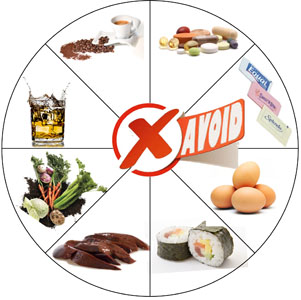
While there are many ways to make sure your diet is rich in healthy, delicious foods, there are also many other things that can be done. Calories are not everything, but they are important. More important than the calories is the nutritional content and ingredients. It is possible to make changes to your diet, such as replacing processed foods by whole grain alternatives. Here are some great options. And remember, eating a variety of different kinds of food is better for you than a single type of food.
Avoid sweetened drinks and snack foods. Added sugar and fat can cause health problems. Most muffins that are sold in stores contain only cake inside a muffin shell. Don't eat "healthy" frozen dinners. They are full of preservatives, sugar, and other harmful ingredients. Most desserts made without fat or gluten are low in nutrients. Many so-called healthy foods are high in artificial junk. Mangos and bananas, high-GI fruits, are rich in natural fiber that is vital for our bodies.
Choose healthy foods that are low in fat, sugar, or both. Those that are high in these nutrients are considered unhealthy. Avoiding them is better than eating too many. If you want to enjoy a treat, then go for the healthier option. Some of the best choices are organic and free-range. If in doubt, talk to your doctor. It's easy to make the switch to a healthier diet. It doesn’t have to take much effort.

Aim for a variety of healthy foods in your diet. Get more fruits and vegetables in your diet. They're healthier for you long term. Remember, you don’t have to eat a lot of calories to enjoy the many health benefits of eating nutritious food. There are many ways that you can enjoy these healthy choices without feeling hungry. You will lose weight and remain healthy if you eat healthy foods.
Many fast-food restaurants are trying to make themselves healthier, but it is important not to confuse the word "healthy” on the packaging. Even healthy foods can contain sugar substitutes, which can actually increase calories and increase the risk for diabetes. People with healthy eating habits should avoid unhealthy food and stick to whole foods. There are many ways to make your diet more nutritious. All you have to do is make healthier choices.
Plant-based proteins are another example of a false healthy food. They're not real meats. These foods are manufactured to look like actual meat and contain high levels of sodium and fat. These foods are not a good choice for your diet. Avoiding these potentially dangerous foods is important. Instead, stick to whole, nutritionally-dense foods. It is crucial that you maintain a healthy balance of both unhealthy and healthy foods in your food intake.
You can opt for organic or raw foods if you prefer a natural choice. Many of these foods are low-fat and rich in antioxidants. They're rich in vitamins C & A. They are also low in calories so they are a great choice for people with diabetes. You should follow your doctor's advice for the best results. These foods are healthy for you. They will keep your blood sugar levels in check.

Some of the most popular yogurts are not as healthy. Most yogurts contain high levels of sugar and flavor. Low-fat yogurt can be found with 15 grams of sugar per cup, which is still quite a lot. You can only get low-fat milk if you buy the unsweetened version. Non-fat frozenyogurt can be used in place of ice cream.
While it is important to avoid high-fat foods you also need to remember that they are full of vitamins and fiber. Avoid high-sugar foods and bars that lack at least threeg of protein. A healthy energy bar should have minimal ingredients and no more than 10 grams sugar. This will allow you to lose weight, improve your health, and help you get healthier. You'll thank yourself later!
FAQ
What are the ten best foods to eat in America?
These are the 10 best foods you can eat:
-
Avocados
-
Berries
-
Broccoli
-
Cauliflower
-
Eggs
-
Fish
-
Grains
-
Nuts
-
Oats
-
Salmon
What is the difference in calorie and kilocalories?
Calories refer to units that are used for measuring the energy in food. Calories are a unit of measurement. One calorie equals one degree Celsius of energy to raise water temperature by 1 gram.
Kilocalories is another name for calories. Kilocalories are measured in thousandths of a calorie. 1000 calories are equal to one kilocalorie.
Is it possible to have a weak immune system due to being cold?
Being cold gives you a weaker immune system because when you are cold, your body produces less white blood cells which fight infections. Being cold can make you feel more comfortable because your brain releases endorphins which help reduce pain.
Why is it important to live a healthy life?
A healthy lifestyle will help us live longer and happier lives. A healthy diet, regular exercise, good sleep habits, and stress management will help prevent diseases like heart disease, diabetes, cancer, and stroke.
A healthy lifestyle will improve our mental well-being and help us deal better with everyday stressors. A healthy lifestyle can also help you feel and look younger.
What is the healthiest lifestyle to life?
Healthy lifestyles include eating healthy food, regular exercise, good sleep, and avoiding stress. This will ensure that you live a long healthy life.
Starting small can make a big difference in your diet, and even your exercise routine. Try walking for 30 minutes each day to lose weight. Or, if you want to get more active, take up swimming or dancing. An online fitness program such as Strava or Fitbit that tracks your activity could be a good option.
These are 5 ways you can live a healthy and happy life.
Healthy living means eating right, exercising regularly and getting enough sleep. It also involves managing stress and having fun. Healthy eating means avoiding sugary and processed foods. Exercise is good for your body and muscles. Getting enough sleep improves memory and concentration. Stress management helps reduce anxiety and depression. Fun keeps us happy and healthy.
Statistics
- According to the Physical Activity Guidelines for Americans, we should strive for at least 150 minutes of moderate intensity activity each week (54Trusted Source Smoking, harmful use of drugs, and alcohol abuse can all seriously negatively affect your health. (healthline.com)
- The Dietary Guidelines for Americans recommend keeping added sugar intake below 10% of your daily calorie intake, while the World Health Organization recommends slashing added sugars to 5% or less of your daily calories for optimal health (59Trusted (healthline.com)
- WHO recommends consuming less than 5% of total energy intake for additional health benefits. (who.int)
- This article received 11 testimonials and 86% of readers who voted found it helpful, earning it our reader-approved status. (wikihow.com)
External Links
How To
What does "vitamin" actually mean?
Vitamins are organic compounds naturally found in food. Vitamins aid us in absorbing nutrients from the food we eat. Vitamins cannot be made by the body; they must be taken from food.
There are two types vitamins: water soluble or fat soluble. Water-soluble vitamins dissolve easily when they are dissolved in water. Some examples include vitamin C,B1 and B2 vitamins (thiamine), B2 and riboflavin, B3 and B6 vitamins (niacin), folic acids, biotin, pantothenic acids, and cholesterol. Fat-soluble vitamins can be stored in the liver or in fatty tissue. You can find vitamin D, E K, A, beta carotene, and other fat-soluble vitamins.
Vitamins can be classified according to biological activity. There are eight major types of vitamins:
-
A - Vital for normal growth and maintaining good health.
-
C - vital for proper nerve function, and energy production.
-
D – Essential for healthy teeth, bones and joints
-
E is required for good vision and reproduction.
-
K - Essential for healthy muscles and nerves.
-
P – vital for building strong bones.
-
Q – aids digestion of iron and iron absorption
-
R - Red blood cells are made from red blood cells.
The recommended daily allowance (RDA) of vitamins varies depending on age, gender, and physical condition. The U.S. Food and Drug Administration (FDA) sets the RDA values.
For example, the RDA for vitamin A is 400 micrograms per dayfor adults 19 years or older. However, pregnant women need 600 micrograms per day because it is important for fetal development. Children ages 1-8 require 900 micrograms per day. Infants under one year of age require 700 micrograms per day, but this amount decreases to 500 micrograms per day between 9 months and 12 months of age.
Children between the ages of 1-18 need 800 micrograms per daily for obesity, while children overweight require 1000 micrograms. Children underweight or obese will need 1200 mg per day.
Children 4-8 years old who have anemia must consume 2200 micrograms of Vitamin C daily.
2000 micrograms per person is necessary for general health. Breastfeeding or pregnant women require 3000 micrograms per daily due to higher nutrient demands.
1500 micrograms is the recommended daily intake for adults aged 70+, who lose approximately 10% of muscle each year.
Women who are pregnant and lactating need more nutrients than the RDA. Pregnant woman need 4000 micrograms daily in pregnancy, and 2500 per day after childbirth. Breastfeeding mothers need 5000 micrograms per day when breast milk is being produced.